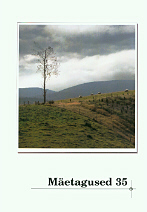Eesti regilaulude verbisemantika
The Verb Semantics of the Estonian Runo Songs
Author(s): Kanni LabiSubject(s): Language and Literature Studies
Published by: Eesti Kirjandusmuuseum
Keywords: Estonian language; Estonian dialects; interrelations between linguistics and folkloristics; language history; runo song; semantics
Summary/Abstract: This paper examines verbs used as parallel (synonymous) words in Estonian runo songs, the semantic structures which they reflect, and the possibilities of expressing special domains of action: motion, perception and speech acts. This is a research of Estonian semantics, based on the material which represents historical and poetic language, the age of which varies from the origin of runo songs about 2000 years ago, to the end of the 19th - beginning of the 20th century, when the analyzed songs were written down. This material gives several possibilities to research diachronic semantics of Estonian, language with not very long literary tradition. On the other hand, in the poetic language the mental semantic structures appear more directly than in the general language, while the poetic text is further structured itself. The key poetical features determining the semantics of runo song language are alliteration and parallelism. The main unit of parallelism is a group of verses, each organized by alliteration, expressing the same or a similar situation by using the same, synonymous or analogous words which are usually in the same positions. The repetition of one idea with different words and the semantic cohesion in parallel verses may produce a result in which words that are normally non-synonymous come to be used as synonymous parallel words. Such a phenomenon has been explained as the hazing of the common word meaning: instead of words with appropriate meaning parallel verses contain words chosen for their matching sounds. My analysis indicates that there are still almost always some semantic motivation in the use of verbs in parallelism.
Journal: Mäetagused. Hüperajakiri
- Issue Year: 2007
- Issue No: 35
- Page Range: 115-140
- Page Count: 26
- Language: Estonian

